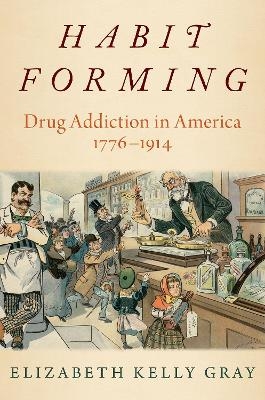
Habit Forming
Drug Addiction in America, 1776-1914
Seiten
2022
Oxford University Press Inc (Verlag)
978-0-19-007312-1 (ISBN)
Oxford University Press Inc (Verlag)
978-0-19-007312-1 (ISBN)
Habit Forming explores American drug addiction and recreational drug use from 1776 to 1914, providing important historical context for the ongoing War on Drugs.
Habitual drug use in the United States is at least as old as the nation itself. Habit Forming traces the history of unregulated drug use and dependency before 1914, when the Harrison Narcotic Tax Act limited sales of opiates and cocaine under US law. Many Americans used opiates and other drugs medically and became addicted. Some tried Hasheesh Candy, injected morphine, or visited opium dens, but neither use nor addiction was linked to crime, due to the dearth of restrictive laws. After the Civil War, American presses published extensively about domestic addiction. Later in the nineteenth century, many used cocaine and heroin as medicine. As addiction became a major public health issue, commentators typically sympathized with white, middle-class drug users, while criticizing such use by poor or working-class people and people of color. When habituation was associated with middle-class morphine users, few advocated for restricted drug access. By the 1910s, as use was increasingly associated with poor young men, support for regulations increased. In outlawing users' access to habit-forming drugs at the national level, a public health problem became a larger legal and social problem, one with an enduring influence on American drug laws and their enforcement.
Habitual drug use in the United States is at least as old as the nation itself. Habit Forming traces the history of unregulated drug use and dependency before 1914, when the Harrison Narcotic Tax Act limited sales of opiates and cocaine under US law. Many Americans used opiates and other drugs medically and became addicted. Some tried Hasheesh Candy, injected morphine, or visited opium dens, but neither use nor addiction was linked to crime, due to the dearth of restrictive laws. After the Civil War, American presses published extensively about domestic addiction. Later in the nineteenth century, many used cocaine and heroin as medicine. As addiction became a major public health issue, commentators typically sympathized with white, middle-class drug users, while criticizing such use by poor or working-class people and people of color. When habituation was associated with middle-class morphine users, few advocated for restricted drug access. By the 1910s, as use was increasingly associated with poor young men, support for regulations increased. In outlawing users' access to habit-forming drugs at the national level, a public health problem became a larger legal and social problem, one with an enduring influence on American drug laws and their enforcement.
Elizabeth Kelly Gray is Associate Professor of History at Towson University.
Acknowledgments
Note on Terminology
Introduction
Part I: Hidden Drug Use in America
Chapter 1: American Use of Opiates, 1776-1842
Chapter 2: American Drug Use Quietly Escalates, 1842-1867
Chapter 3: The Vogue for Hashish, 1832-1884
Part II: Learning from a World of Users
Chapter 4: The Global Context, 1774-1862
Chapter 5: Habitual Opiate Use in Great Britain, 1821-1877
Chapter 6: The Drug Trade and Habitual Use in China, 1804-1881
Part III: An Open Problem
Chapter 7: American Opium Dens, 1850-1910
Chapter 8: A Public Problem, 1867-1905
Chapter 9: Federal Regulation Begins, 1875-1914
Conclusion: The Hydra Emerges
Notes
Bibliography
Index
| Erscheinungsdatum | 21.11.2022 |
|---|---|
| Zusatzinfo | 8 black and white illustrations |
| Verlagsort | New York |
| Sprache | englisch |
| Maße | 156 x 235 mm |
| Gewicht | 626 g |
| Themenwelt | Geisteswissenschaften ► Geschichte ► Regional- / Ländergeschichte |
| Geschichte ► Teilgebiete der Geschichte ► Kulturgeschichte | |
| Studium ► Querschnittsbereiche ► Geschichte / Ethik der Medizin | |
| ISBN-10 | 0-19-007312-8 / 0190073128 |
| ISBN-13 | 978-0-19-007312-1 / 9780190073121 |
| Zustand | Neuware |
| Haben Sie eine Frage zum Produkt? |
Mehr entdecken
aus dem Bereich
aus dem Bereich
der stille Abschied vom bäuerlichen Leben in Deutschland
Buch | Hardcover (2023)
C.H.Beck (Verlag)
23,00 €
vom Mittelalter bis zur Gegenwart
Buch | Softcover (2024)
C.H.Beck (Verlag)
12,00 €
Die Revolution des Gemeinen Mannes
Buch | Softcover (2024)
C.H.Beck (Verlag)
12,00 €


